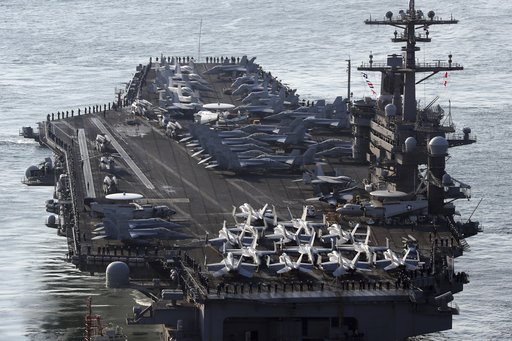SYDNEY—US supercarrier Carl Vinson will arrive in the Sea of Japan in days, Vice President Mike Pence said Saturday, on a visit to Australia aimed at mending fences following a testy first call between the countries’ leaders.
Pence sought to put to rest the surly telephone conversation between US President Donald Trump and Australian Prime Minister Malcolm Turnbull in January, which rattled a long-standing alliance between the two powers.
Trump reportedly exploded and cut short the call when he was told about a deal to move some refugees from Pacific island camps to America, which he branded “dumb”.
“The United States intends to honor the agreement,” Pence said Saturday, but added that it “doesn’t mean we admire the agreement”.
The US commitment to take the refugees was “a reflection of the enormous importance of the historical alliance between the United States and Australia… whatever reservations the president may have about the details”, he said.
Turnbull thanked Pence for the “very important” commitment.
The Trump administration has also been trying to clear the waters after sending out confusing messages over the location of the Vinson carrier group that was supposedly steaming toward North Korea last week.
READ: US carrier strike group told to sail toward Korean Peninsula
Tensions between the US and the North have soared recently following a drumbeat of missile tests and fears that Pyongyang may be readying a sixth nuclear test.
“Our expectation is that they will be in the Sea of Japan in position in a matter of days, before the end of this month,” Pence told reporters in Sydney.
“(What) the regime in North Korea should make no mistake about, is that the United States has the resources, the personnel and the presence in this region of the world to see to our interests and to see to the security of those interests and our allies,” he said.
The US Navy on April 8 said it was directing a naval strike group headed by the USS Carl Vinson aircraft carrier to “sail north” from waters off Singapore, as a “prudent measure” to deter the hermit regime.
“We are sending an armada. Very powerful,” said President Donald Trump as other officials made it sound like the ships were steaming toward the region.
Pentagon chief Jim Mattis said the Vinson was “on her way up”.
But the Navy admitted Tuesday the ships were in fact sent in the opposite direction — away from Singapore and toward Australia to conduct drills with the Australian navy.
‘China can do more’
Pence and Turnbull on Saturday also praised China’s role in the Korean crisis but renewed calls for Beijing to use its “unique” position to bring Pyongyang to heel.
Beijing is Pyongyang’s only major ally and biggest trade partner, and has come under increasing pressure from the US to do more to rein in the North.
Turnbull voiced his own concerns earlier this month, saying China has an obligation to use its “enormous leverage” to bring the nuclear-armed state back from the brink, toughening Canberra’s position on the escalating crisis.
“The steps we’re seeing China take, in many ways unprecedented steps, bringing economic pressure to bear on North Korea are very welcome,” Pence said.
“We do believe China can do more,” he added.
READ: China left as observer as tensions rise on Korean Peninsula
Washington and her allies were working together “to encourage China to take those steps necessary to bring about a peaceable solution to achieve a nuclear free Korean peninsula.”
China’s “new engagement” was positive, Pence said.
“We continue to be hopeful and continue to have great confidence that we can finally after a generation achieve a peaceable solution.”
Pence said Wednesday that the United States would counter any North Korean attack with an “overwhelming and effective” response.
His comments came after senior North Korean official warned the regime had no intention of scaling down its missile program, pledging weekly tests and threatening “all-out war” if the US took any action against it.
Trump’s deputy visited South Korea and Japan before Australia to reassure allies fretting over Pyongyang’s quickening missile program.
